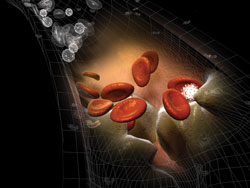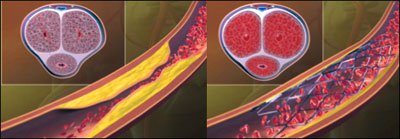DES: A Promising Future Strategy for ED
|
|
A drug-eluting peripheral stent system was shown for the first time in clinical research to be a safe and efficacious treatment for erectile dysfunction, according to results from the ZEN trial presented at the Vascular Interventional Advances 11 meeting in Las Vegas.
“Many people believe that phosphodiesterase type 5 [PDE5] inhibitors are a panacea for erectile dysfunction [ED], but they’re not. There is a significant non-responder discontinuation rate,” Jason Rogers, MD, director of interventional cardiology, UC Davis Medical Center, Sacramento, Calif., and one of the trial investigators who presented the findings, told Cardiology Today Intervention. “But there are not a lot of other therapies available for ED.”
 |
|
| Jason Rogers |
This led Rogers and fellow investigators of the multidisciplinary ZEN trial, including Krishna Rocha-Singh, MD, director of the Prairie Vascular Institute, Springfield, Ill., and Irwin Goldstein, MD, director of San Diego Sexual Medicine at Alvarado Hospital, San Diego, to test stenting in this indication, which he said is an entirely new procedure and technique with no precedent in medical research. “It’s a completely new field of vascular medicine, and that is one of the most exciting parts of the study,” he said. “The study also heightens the awareness of the connection between ED and CVD. Most vascular physicians in general probably don’t ask their patients about ED, but they should because there is a strong link between the two.”
Behind the ZEN Trial
In the multicenter, nonrandomized ZEN trial, Rogers and colleagues enrolled 30 men who were at least 18 years of age and had a suboptimal response to PDE5 inhibitor therapy. All men were in a stable sexual relationship and had peak systolic velocity of cavernosal arteries of less than 30 cm/sec, and, if angiography showed focal disease, underwent stenting of the pudendal artery with a zotarolimus-eluting peripheral stent system (Medtronic). Primary endpoints included safety, or major adverse events at 30 days, and feasibility at 3 months, which was defined as improvement in erectile function in at least 50% of patients of no less than 4 points on the International Index of Erectile Function (IIEF) questionnaire.
At 30 days, there were no major adverse events reported. After excluding eight patients who were either unavailable for follow-up or who did not have stenting performed of the pudendal artery, 68.2% of those remaining had improvements in erectile function of at least 4 points, meeting the criteria for feasibility.
“Patients also had a duplex of the penis and we confirmed that by stenting we actually increased blood flow, which correlated with the clinical improvement,” Rogers said.
How the Procedure Works
Similar to coronary stenting, the patient does not feel the stent, Rogers said, a feat achieved by stenting the internal pudendal artery.
|
Image: Jason Rogers, MD |
“It’s a 15-cm long artery deep in the pelvis. We did a pilot angiographic study published in 2010 because no one had ever described this vessel angiographically and the disease patterns,” he said. “So we looked at men who had CVD and ED and were poor responders to PDE5 inhibitors, and we found that they had atherosclerotic narrowings in the vessel. From a procedural standpoint, the stenting process was one of the more basic parts of the whole study in that the stent technique used was very similar to stenting any other vessel.”
Population Considerations
Although ED presently affects 30 million men in the United States, and more than 300 million men worldwide, Rogers foresees a more modest number being helped by stenting in this indication.
“This is not a procedure that will apply to every patient with ED, and there is a lot of research we need to do to identify which patients will benefit and how to best screen these patients,” he said. “The complete evaluation of a patient with ED requires a urologist and a sexual medicine expert. Any patient with ED should have a thoughtful evaluation for all the causes of ED, and I would caution against routinely looking for a stent solution as the first approach for ED management. In the end, we are looking for a very select group of patients, but given the large number of men affected by ED, even a minority of patients would be a lot.”
As to whether men would be willing to pay for an interventional procedure to improve erectile function as they would coronary blood flow, Rogers was confident that they would.
“Most of what we do in medicine involves improving quality of life, and ED has been extensively studied in this regard and ranks very highly,” Rogers said. “In fact, most men may rank their ability to achieve an erection as one of their top concerns for their health. So, in terms of clinical benefit and QOL, it’s huge; but in terms of its cost-to-benefit ratio, that has yet to be determined.” – by Brian Ellis
References:
Rogers J. Presented at: Vascular Interventional Advances 11; October 18-21, 2011; Las Vegas.
Disclosure: Dr. Rogers is a consultant for Medtronic.

![]()
|
|
This is a highly anticipated trial because it offered an expansion of the interventional cardiology space, represented a new opportunity for collaboration with urologists, and offered a versatile and potentially permanent solution to a common and etiologically complex problem that has substantive effects on QOL. This was a preliminary analysis of this first-in-man, nonrandomized safety and feasibility trial, and the results are very promising. In fact, there were no major adverse events at 30 days and the 3-month (functional) improvement in the IIEF was seen in about 60% of subjects. Angiographic and duplex ultrasound results were reasonable, even though it does not appear that core laboratory adjudication was done.
It is notable that enrollment was unusually slow over the 2-year trial period: only 30 subjects (goal was up to 50) were enrolled in the 16 sites (number of sites was increased from nine initially to 20, and 16 were activated). Given that ED is common and urologists were intimately involved in this trial, the sluggish enrollment raises concerns that trial subjects may have been overly selected based on scrupulous screening protocol that may in fact limit its external validity. Furthermore, it may also reflect the reluctance of investigators (cardiologists and urologists) to embrace [this strategy] and offer the trial to ED patients and/or reluctance on the patient side to be part of it. Notably, a successful procedure did not eliminate the need to take PDE5 inhibitors for satisfactory result. This also points to the complexity of this disease and the impact of the pathological changes in the small vessels of the penis in such patients.
In summary, this is a much welcomed, promising proof-of-concept, safety and feasibility trial that offers a new treatment for a difficult condition. After all, ED may actually be, at least in some patients, viewed as a chronic ischemic condition and interventional cardiologists may be able to remedy it. We will eagerly await the longer-term clinical and angiographic data and results of the larger IMPASSE trial.
– Amjad AlMahameed, MD, MPH
Cardiology Today Intervention Editorial Board member
Disclosure: Dr. AlMahameed reports no relevant financial disclosures.



